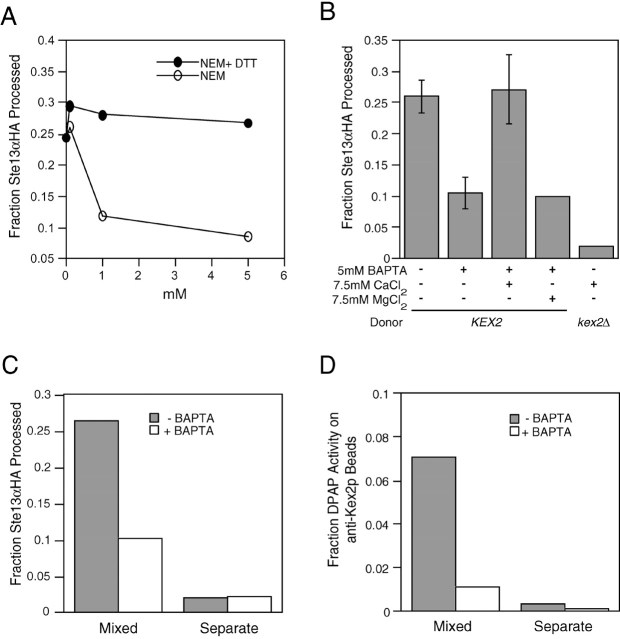Figure 4.
TGN membrane fusion is NEM-sensitive and requires Ca 2+. (A) Donor and acceptor MSS membranes were treated separately with NEM or equimolar ratio of NEM + DTT at 30°C for 5 min. NEM was quenched with equimolar concentration of DTT on ice before initiating reactions. (B) MSS membranes were pretreated with 5 mM BAPTA, 7.5 mM CaCl2, or 7.5 mM MgCl2 for 1 h on ice. Higher processing of Ste13αHA was observed when 7.5 mM CaCl2 was added to standard reactions (unpublished data). To confirm that this additional processing was due to Kex2p, control reactions using kex2Δ MSS membranes were performed in the presence of 7.5 mM CaCl2. Complete inhibition could be achieved with higher BAPTA concentrations. However, at these BAPTA concentrations addition of equimolar Ca2+ did not restore more than 50% of the wild-type reaction (unpublished data). (C) BAPTA inhibits membrane fusion and not Kex2p activity. Mixed and separate reactions between MSS membranes pretreated with 5 mM BAPTA or buffer as in B were performed as described in the legend to Fig. 2 A, and the fraction of Ste13αHA processed in each reaction is indicated (C). (D) The remainder of the mixed and separate reactions was bound to anti-Kex2p beads, washed, and assayed for the percent of total DPAP activity that remained bound to the beads as in the legend to Fig. 2 B. Roughly 1% of the DPAP activity from the BAPTA-treated mixed reactions was associated with the anti-Kex2p beads, whereas 7% of the DPAP activity from the control mixed reaction (−BAPTA) coisolated with the beads, demonstrating that cointegration of the Ste13αHA and Kex2p into the same membranes and not simply the processing of the substrate by Kex2p was blocked by BAPTA.

